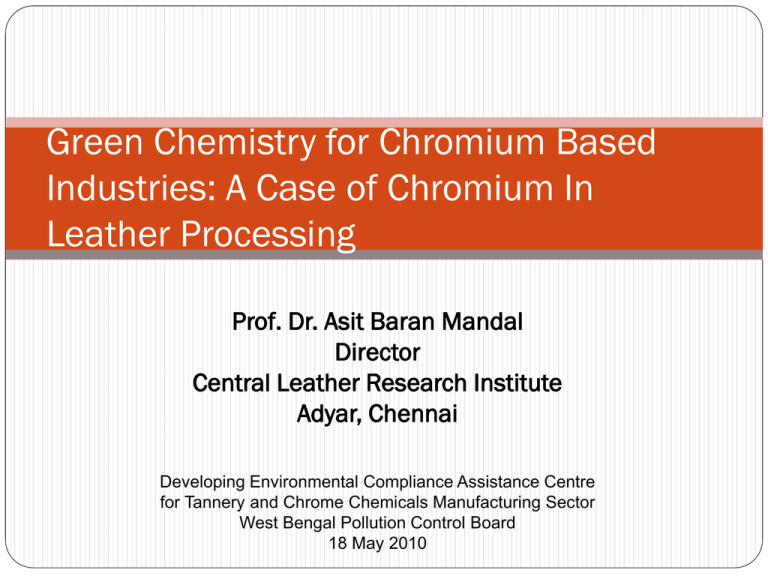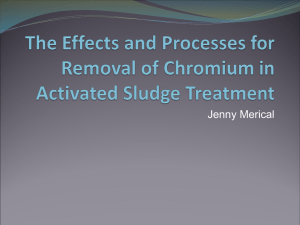Green Chemistry for Chromium Based Industries
advertisement

Green Chemistry for Chromium Based Industries: A Case of Chromium In Leather Processing Prof. Dr. Asit Baran Mandal Director Central Leather Research Institute Adyar, Chennai Developing Environmental Compliance Assistance Centre for Tannery and Chrome Chemicals Manufacturing Sector West Bengal Pollution Control Board 18 May 2010 Chromium: Industrial Applications Cr(VI) Recycled Cr(III) Metallurgy chromium Ore dressings Galvanizing Recovered Cr Tanning hydroxide from Electroplating Pigments/dyes tanning Pigments /dyes Fine chemicals Fine chemicals Chromite Mining How to avoid Cr(VI) formation? Chromite Processing How to avoid Cr(VI) leaching? How to overcome size limitations in Cr recovery? Downstream Applications How to respond to ecobans? Tanning What do we do with chromium containing solid wastes? Pigments Can we replace/substitute Cr in Tanning? Can we replace/substitute Cr in pigments? Knowledge Gaps Gap Areas in Green Chemistry for Chromium Based Industries Green Chemistry Initiative for Chromite Mining Technologies Chromite Ore Milling Cr(VI) Fines 40-65 mgkg-1 Frictional Heat • HCrO4- + 3Fe2+ + 7H+ ---- Cr3+ + 3Fe3+ + 4H2O – Practical difficulties for large volumes of treatment – Generates SO42- ions • A natural product containing gallic acid chosen as reductant and proton source – Myrobalan (Terminalia chebula) a hydrolysable tannin containing glucose and gallic acid used – Process does not produce sulfates Concentration of Myrobalan (g/Kg Ore) Residual Cr(VI) (mg/Kg) 1.0’ 2.0’ 15’ 7 2.5 1.1 0.09 15 1.0 0.03 0 65 0.05 0 0 125 0.02 0 0 Innovation of Commercial Acceptance Implemented at M/s. Tata Iron & Steel Co., Jamshedpur Chromium(VI) in Solid Residues from Ore Processing Chromite FeCrO4 O2, 1300oC Chromate CrO42- H+ Residue Dichromate Cr2O72- 1 ton chromite ore processing residue (COPR) generated per ton chromate produced 15-20% of Cr in COPR is mobile For e.g. hydrogarnet - (Ca3Al2(OH)12(CrO4)3), hydrocalumite - (Ca4Al2(OH)12(CrO4)6H2O) and ettringite - (Ca6Al2(OH)12(CrO4)3 26H2O) Current day methodology is to immobilize these Cr(VI) forms as Cr(III), followed by land filling Fe + CrO42- + 0.5 H2O + 2H+ → Fe(OH)3 + 0.5 Cr2O3 6Fe2+ + 2CrO42- + 13 H2O → 6 Fe(OH)3 + Cr2O3 + 8H+ Unsolved problem: Leaching of Chromium Insecurity with the Secure Landfill Green Chemistry for Chromite Ore Processing Industries Currently employed process chemistries of chromite ore processing residues are based on immobilizing the 15-20% of mobile chromium Our novelty is to mobilize totally and selectively the immobile chromium. This would take some doing by change of process chemistry We have been able to select a process chemistry for mobilizing all chromium in COPR selectively Influence of Nature of Extractant on Chromium Mobilization Na2O2 + 2H2O 2NaOH +H2O2+ Heat H2O2 H2O + ½O2 Cr2O3 + 4NaOH + 1.5O2 2Na2CrO4 Extractive strategies of chromium need to overcome diffusion problems. COPR sizes vary in mm to cm. How do we access chromium within this residue? Extractant Na2O2 %Cr Mobilized Particle size Reduction (%) 0.2 mm 2.0 mm 0.2 mm 2.0 mm 96.2 95 90 85 Issue of Concern: Accessibility to occluded Cr Options Available: Mechanical or Oxidative breakdown of particles Leather: A Down Stream Chromium Based Industry Green chemistry foresight Chromium in Tannery Wastewaters: Needing Specific Solutions Chrome Tanning ~3000 mg/L Rechroming ~1000 mg/L Dyeing & Fatliquoring ~100 mg/L Washings ~250 mg/L Chromium in ETP Sludge ~50000 mg/kg Chromium in leather wastes ~20000 mg/kg Four Part Approach Recognize what is not absorbed and coax the unbound chromium to bind through structural modification Incremental change approach Recover the unbound chromium and reuse in another form Near zero Cr discharge tanning methodology Identify what is not used and avoid the formation of undesirables. Near zero- (Cr) discharge tanning salt approach When the rogue species persist, replace the element of chromium as a whole Chromium free approach Chrome Tanning : Its Impact in India ~ 1 billion kgs of hides/skins processed annually ~ 90% hides/skins receive chrome tanning Chrome exhaustion levels vary in commercial units from 40 - 70% of Cr used About 40,000 tons of BCS per annum consumed annually About 4,000 tons of Cr wasted annually Tanneries face legislative pressures ~ 40 crore worth of chrome salts wasted annually End of pipe treatment affords large amounts of chrome sludge (160,000 tons per annum) Disposal of sludge is a serious problem Secured Chrome Management: An Imminent Need Possible Causes for Poor Uptake of Chromium(III) High kinetic inertness of Cr(III) ions Lower binding constants for the complexation with functional sites in collagen Diffusion related difficulties Lack of availability of Cr(III) binding sites in protein Chromium Species: Varied Binding Degree of Polymerization Shrinkage Temperature (oC) 2 (dimer) 100 3 (trimer) 84 4 (tetramer) 68 Native collagen 60 5+ OH Cr Cr 4+ OH Cr Cr OH OH HO Cr OH Dimer, 1 Trimer, 2 4+ OH Cr Cr OH O O OH Cr Cr OH Tetramer, 3 A True Scientific Solution to the Problem of Poor Uptake Involves Avoiding the formation of low affinity species Modifying the chemical structure of tetramer Converting low affinity into high affinity species Developing a near zero waste material Developing a near zero waste tanning method Designing a High Uptake BCS Salt Factors influencing the quality of BCS Cr(VI)/acid ratio Reaction temperature Order of addition of reductant/acid Rate of addition of reductant/acid Basification pH Ageing time Mode of drying Scavenging the precursors leading to the formation of tetramer in manufacture of BCS is the process logic. A new modified BCS salt exhibiting >85% Cr exhaustion prepared and commercialized Technology developed and transferred to M/s. Golden Chemicals Ltd., Mumbai Chrome Tanning: Current Practices Currently employed chrome tanning methods require acidification (pickling) as a preconditioning process This causes not only TDS emission but also requires a deacidification step (Basification) An ordinary pickle-free chrome tanning process employs conventional basic chromium sulfate salt at a higher pH The unsuccessfulness of this process are the danger of swelling, poor penetration and low uptake of chromium Calls for single step chrome tanning …… Pickle-less Chrome Tanning: Process Profile A new strategy has been designed to carry chrome tanning without pickling and basification steps with the help of formaldehyde free polymeric synthetic tanning agent Know-how transferred to M/s Balmer Lawrie and Co. Pickle–Basification Free Chrome Tanning tanning leads to substantial TDS and chromium load A pickle–basification free chrome tanning at pH 5.0 developed A polymeric matrix based syntan has been prepared for pickle-less tanning Chrome exhaustion is improved from 70 to 94% The product enables reduction in TDS and chlorides by 85 and 99% Emission load (Kg/ton of raw skins) Conventional method of chrome 160 140 120 100 80 60 40 20 0 TDS Cl Chrome Recovery and Reuse: An Easy and Practicable Solution This involves the precipitation of all unbound chromium in the form of chromic hydroxide and redissolution for reuse under controlled conditions. Batch processes are adopted based on the use of magnesium oxide as alkali Adopted by all chrome tanning units in India A continuous process developed to increase process capacity Provides wealth from waste Semi-Continuous Chrome Recovery – Design Features Na2CO3/NaOH Cr(OH)SO4 Neutralization Tank Cr(OH)3 Flow Tube Primary Settler Stable hydrostatic Pressure Improved aggregation Better compaction Instantaneous pH 8.0-8.5 Increased friction Improved interaction Aggregation Secondary Settler For trapping fine particles Continuous Chrome Recovery: In Industrial Practice Under steady state conditions, the fluid flow into and out of the settler are matched The process is independent of nature of alkali and can be used to treat effluents containing oils and fats and low concentrations of chromium Implemented at Tannex. Panruti (24 MLD) Chromium Recycling: Challenges Direct recycling of chromium into the pickling process leads to surface fixation and coarseness of the skin surface This can be overcome through Preacidifying the spent chrome liquor to pH 1.0 to convert cationics to anionics, thereby enabling direct recycling Implemented in 4 Units under the Collaborative Program with CSIRO Australia High Exhaust Chrome Tanning: A New Methodology Based Logic Employ a tailor made aluminium salt (Alutan) which resists hydrolysis and precipitation at tanning pH conditions Alutan-BCS Combination Tanning Employ easily available materials Permits closed pickle-tan loop Enables near zero waste tanning Easy to adopt Field experience gained and shared Help in containing sulfate discharge Implemented in 9 Units under the Leather Technology Mission, GoI Closed Loop Tanning Chromium Bearing Solid Wastes: Issues Generation: 5600 tons per annum Cr concentration in dry waste: 2-3 g/kg Moisture: 50% Current disposal methods Leather boards Dumping low lying areas Incineration Hydrolysis to recovery gelatin Issues of concern Leaching of Cr into soil and groundwater Air pollution Risk of converting Cr(III) to Cr(VI) Semi-Chrome Tanning: Unique Issues of Concern to India Chrome tanning carried out after vegetable tanning Process sequence employs a stripping process after vegetable tanning prior to chrome tanning Wastewater after chrome tanning contains a mixture of polyphenols (6000 mg/L) and chromium (2500 mg/L) Conventional precipitation of chromium as its hydroxide results in co-precipitation of quinones and other intermediates from the tannins Oxidative treatment to remove tannins results in Cr(III) Cr(VI) conversion Current option is to dispose the chromium bearing wastewater to effluent treatment plants, where chromium precipitates along with tannins Solution to the problem: Selective Removal of Tannins Chrome Shavings – As an Adsorbent Collagen contains both COO- and NH2+ groups Chrome tanning process blocks the COO- groups significantly Chrome shavings presents A low/zero cost adsorbent Predominant absence of COO- groups Presence of –CO, -CO-NH and NH2 groups for binding vegetable tannins Selectivity! Chromium-Collagen : Vegetable Tannin Interactions The Issue The Solution Removal of vegetable tannin from a Conventional adsorption processes waste water containing chromium and tannins increased with pH Commonly used mimosa under the pH investigated is anionic and hence instantaneously complexes with Cr-Collagen (shaving) However, at pH values above 5.0 chromium would precipitate as its hydroxide To avoid formation of Cr-hydroxide and quinones adsorption studies were carried out at pH 3.5 adopt desorption as the subsequent step. Adsorbed tannins have no utility value It has now been possible to use the adsorbed shavings as a reductant in the place of molasses in the manufacture of basic chromium sulfate for leather processing Three Pot Solutions to Leather Wastes & Waste Waters Cr-Veg effluent Dye stream In the first pot the chromium bearing shaving dusts have been used as adsorbents to selectively remove tannins from tannin-chromium mixed wastewaters or dyes from dye bearing streams In the second pot the tannin/ dye adsorbed shaving is used as reductant and a source of electron, in the place of molasses, to generate basic chromium sulfate from Cr(VI) for use in tanning industry In the third pot the tannin/dye free chrome liquor is precipitated, redissolved in sulfuric acid, to generate chromium(III) sulfate liquor for tanning Tannin/dye Adsorbed shavings Cr(VI) Reduction Cr Shaving Tannin/ dye free Chrome liquor Na2CO3 CrIII(OH)3 BCS H2SO4 Advantage of the Three Pot Method An effective and inexpensive method for treating phenolics/ dyes bearing waste waters Simplicity in operation No sludge formation Aerobic oxidation methods require large space and higher levels of process control Oxidation processes like Fenton’s method result in undesirable end products Other catalytic methods are not economical in large scale applications Green Chemistry for Chromium Based Industries: Some achievements with industrial level success Chromite Mining Chromite Processing How to avoid Cr(VI) formation? How to avoid Cr(VI) leaching? How to overcome size limitations in Cr recovery? Use myrobalan Implemented at Jamshedpur Mobilize & recover instead of Immobilizing Searching for industrial partner Adopt semi-continuous methods Implemented at Panruti Downstream Applications How to respond to ecobans? Adopt Cr-Fe tanning and phenolic striking Adopt three pot approach Tanning What do we do with chromium containing solid wastes? Pigments Can we replace/substitute Cr in Tanning? Can we replace/substitute Cr in pigments? Substitute the chromium Use rare earth pigments Thank You






